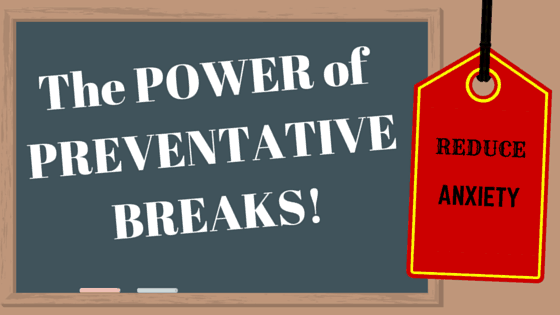Highly Anxious Students – what to do

For many students on the Autism Spectrum, their biggest challenge is anxiety. This can be anxiety about making choices, friendship, making mistakes, separation anxiety, any change in routine or staff and the list goes on.
Research has shown that more than 75% of all children with an ASD, ODD, ADHD experience INTENSE anxious feelings.
Some students show their anxiety; others have a veneer of coping and keep things bottled up. In either case you need to be aware of what is building anxiety in this student. All students with ASD will need a range of calming activities at school. Some students will need to access these activities more often than others. But in our experience you will need to consider some of the ideas below. Otherwise, the anxiety escalates and results in a meltdown.
Often students who bottle up their anxiety will have a huge meltdown when they get home because of things that have happened at school during the day. When home and school are aware of the triggers for anxiety (eg Relief – Teacher) and both are consistent with calming strategies we find that anxiety levels in the student decrease and we see less shutdowns or meltdowns.
Key Strategy – The Power of Preventative Breaks
You will need to teach students a range of strategies to calm themselves. When you are teaching them, you will begin to notice which ones are more effective at calming. You can then write Social Scripts and use visual cards to help them remember what to do when they feel anxious.
- Students self-regulating their anxiety is a VERY important part of their behaviour management programme.
- A student being able to request a break before a meltdown is a fantastic strategy.
Download Easy To Print Version 25 Strategies for PREVENTATIVE BREAKS
Anxiety ASD and the Power of Preventative Breaks
Research has shown that more than 75% of all children with an ASD experience INTENSE anxious feelings. Today education is full of choices, open ended tasks and constant changes. For most students this makes learning interesting BUT for students with an ASD, ADHD, ODD, etc this creates many challenges and one of these is anxiety.
Anxiety can look like:
- Avoidance of new situations
- Preference for sameness
- Rigidity
- Insisting on same rules/routines
- Social withdrawal
- Anger
- Meltdowns
- Repetitive noise, movement or sentences
The Power of Preventative Breaks
You will need to teach students a range of strategies to calm themselves. When you are teaching them, you will begin to notice which ones are more effective at calming. You can then write Social Scripts and use visual cards to help them remember what to do when they feel anxious.
- Students self-regulating their anxiety is a VERY important part of their behaviour management programme.
- A student being able to request a break before a meltdown is a fantastic strategy.
Programmes that can help manage anxiety
- Understanding emotions and emotional control.
- Cognitive Behaviour Therapy see Dr Tony Attwood’s series of books on anger management and anxiety management.
- Relaxation Therapy.
- Sensory Integration Therapy (as sometimes sensory issues can cause anxiety, for example worrying about a whistle in Physical Education).
We must remember that students with ASD feel the vibes and emotions emanating from others. However, it is difficult for them to make sense of these emotions and to work out which one they need to address first.
Key Strategies for Preventative Breaks
There are a range of strategies you can use for breaks and here are some to get you started.
Sensory Breaks
- Remember that some children become hypo aroused while others hyper aroused.
- Chewing (allowing to chew gum, chewy tube etc).
- Quiet area.
- Listening to music.
| Remember:
All of these strategies need to be taught and practiced before they become effective |
- Watching liquid timer.
- Humming, rocking.
- Sitting under a table with blanket over it.
- Carrying heavy books, box.
- Lying under a gym mat, weighted vest etc.
Physical Breaks
- Mini trampoline.
- Rolling on large exercise ball.
- Star jumps, jumping.
- Push up against wall.
- Walk, run.
Relaxation Breaks
- Counting
- Breathing
- Music
- Imaginary world (some students escape into an imaginary world, this is particularly common for girls on the spectrum).
Non-Threatening Withdrawal: Diversion before Meltdown
- Send on an errand.
- Get them to do a job for you.
| When sending on an errand make sure they feel you are helping them and not punishing them! |
Solitude Suggestions
- Safe haven.
- Special interest time.
- Book to read.
- Sit away from group. Eg: If you are on the mat, let them sit at a table away from the group or if you are doing group work and the room is noisy, send their group outside.
- If you are lucky enough to have a small room off your classroom, create a space for them to work there.
Other Strategies may include
- Toilet break, Drink and /or Food.
- Talking to mentor.
- Time breaks.
For the many of you that have my book ‘The Ultimate Guide To School & Home’ there are a number of great strategies to help with Anxiety, see these pages:
- 7 Key Strategies to Creating a Calm Environment (see page 81-82)
- 6 Key Strategies for Creating a Calming Area at School and Home (see page 82)
- 5 Key Steps to Developing Self Calming Strategies (see page 83)
- Sensory Processing (page 84-86)
- Meltdown, Shutdowns & Catastrophic Reactions (page 87-89)


 Sorry we no longer ship items outside Australia. Please consider the digital versions of Sue’s Books –
Sorry we no longer ship items outside Australia. Please consider the digital versions of Sue’s Books – 